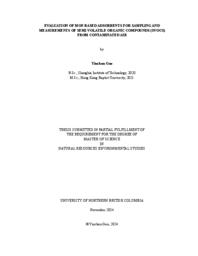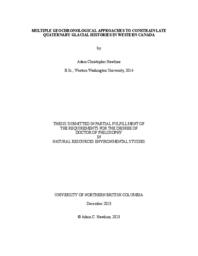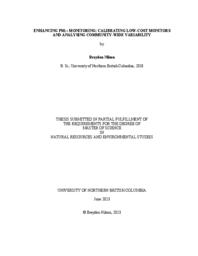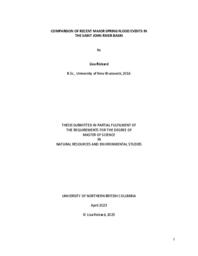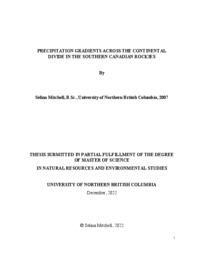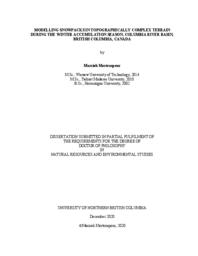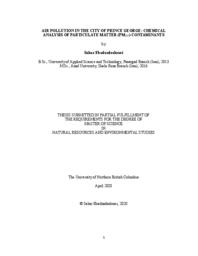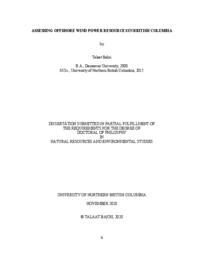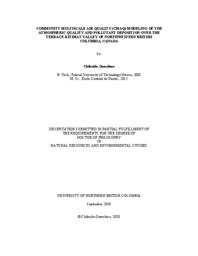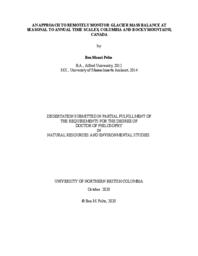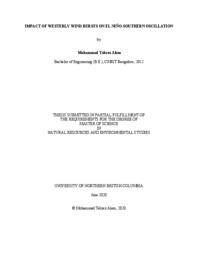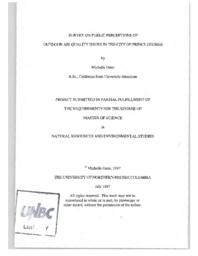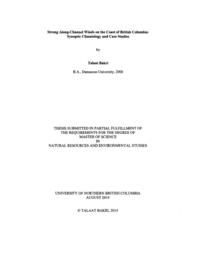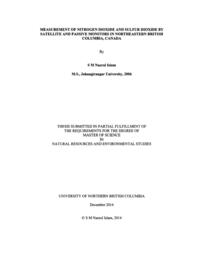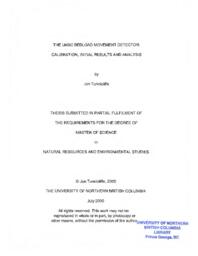Jackson, Peter L.
Person Preferred Name
Peter L. Jackson
Related Works
Content type
Digital Document
Origin Information
Content type
Digital Document
Origin Information
Content type
Digital Document
Origin Information
Content type
Digital Document
Description / Synopsis
My dissertation investigates late Pleistocene and Holocene glacier change in western Canada and is presented in five chapters. In chapter one, I discuss the importance of the cryosphere, the techniques used for reconstructing past glacier behavior, previous research that has contributed to our current understanding of past glacier change, and the objectives and structure of my dissertation. In chapter two, I complete a multi-proxy investigation of Holocene glacier change at Gilbert Glacier, in the Southern Coast mountains. I use radiocarbon dating of lateral moraine stratigraphy and cosmogenic nuclide surface exposure dating to constrain the timing and duration of late Holocene advances at Gilbert Glacier to 2.0–1.8, ~1.5–1.3, ~0.9–0.8, and 0.4–0.1 ka. Organic matter associated with glacier advance within the north-lateral moraine at Gilbert Glacier records advances at 4.8–4.6, 4.5–4.3, 4.0–3.9, 3.8–3.6, 3.4, 3.2–2.9, 2.7, and 0.5–0.3 kilo calendar years BP (ka; 2-sigma age range). I advocate for the tandem use of multiple glacial geochronologic tools to better constrain the onset and termination of glacier advances. Chapter three applies cosmogenic surface exposure dating to a previously understudied region in the Mackenzie and Selwyn mountains of the eastern Yukon and Northwest Territories to develop a late Holocene glacier chronology. Surface exposure ages from 27 moraine boulders across nine glaciers show that glaciers reached their greatest Holocene extent between 1600-1850 CE. I use this glacier chronology to tune a glacier model forced by models of past climate to estimate regional changes in ice volume over the past millennium. Additionally, I use the same glacier model to estimate that glaciers in the region will decline in ice volume by 85% - 97% by 2100 CE. Chapter four returns to the southern Coast mountains where I use cosmogenic dating on moraine boulders, bedrock surfaces, and shallow bedrock cores to investigate the history of deglaciation and Holocene glacier behavior of a small cirque glacier. Bedrock surfaces within and outside of the late Holocene maximum extent of the glacier record complex burial and exposure histories. I employ a Monte Carlo approach to evaluate the most likely glacier history that can be explained by our data. I discuss how our results compare with the work of previous chapters and past research, and the limitations of this technique to constrain the many variables that impact surface exposure ages. Chapter five provides a summary of my study’s major findings and further discusses their limitations and broader implications. I conclude with recommendations for future research that will expand on the work presented in this dissertation.
Origin Information
Content type
Digital Document
Description / Synopsis
Fine particulate matter (PM2.5) air pollution is a significant health concern for the global population. The increasing frequency, intensity, and duration of wildfire smoke events continues to worsen people’s exposure, regardless of their proximity to other major sources such as industry and roadways. To mitigate this exposure, it is crucial to understand the variability of PM2.5 in both space and time. However, the current PM2.5 monitoring network in Canada is limited to major population centres, due to the prohibitive costs of maintenance and deployment. In this study, we propose that low-cost air quality monitors are a viable solution to supplementing this monitoring network. Chapter 2 presents a comprehensive evaluation of these low-cost monitors by comparison with monitors from regulatory networks, including the development of a general-use bias correction model to improve their data quality. The focus of this analysis was to ensure optimal performance in the moderate to high concentration range, where variations in the concentrations have the greatest impact on human health. Chapter 3 demonstrates the application of this bias correction model to a network of low-cost monitors in a northern Canadian city. The data generated by this network was then combined with a novel interpolation method to assess the spatial and temporal variation in PM2.5 concentrations. This analysis represents a valuable resource for any population centre with a sufficient number of monitors installed, and has the potential to inform the siting of new regulatory monitors in locations without existing coverage.
Origin Information
Content type
Digital Document
Origin Information
Content type
Digital Document
Description / Synopsis
This project examines precipitation patterns across the Continental Divide in the southern Canadian Rockies with a focus on precipitation gradients. This thesis is part of the Storms and Precipitation Across the continental Divide Experiment (SPADE) that occurred between 26 April 2019 and 26 June 2019. Daily meteorological data were also examined between 2011 and 2019. The study area encompassed mountainous topography from the Columbia Valley in eastern British Columbia, to a transect of stations alongside the Foothills in western Alberta, with a range of elevations from about 750 m to about 3500 m above sea level. Local station data were derived from three meteorological stations developed for the SPADE campaign, Nipika Mountain Resort (Nipika), Fortress Junction, Fortress Mountain and a tipping bucket transect. Regional station data were derived from several meteorological station networks with publicly available data. Gridded data included ERA5 and ERA5-Land. Cumulative precipitation amounts were the focus of this study, but temperature, relative humidity, and wind speed and direction were also included in my analysis. The objectives of this project are to examine relationships between precipitation gradients/patterns and elevation, cool and warm seasons, general wind patterns/storm trajectories, and inter-annual and intra-annual variability. Elevation is a predictor of precipitation amounts in our study region, and over most time-frames it was a stronger predictor than latitude and longitude in determining precipitation amounts, but the relationship between elevation and precipitation was not always significant. On average precipitation increases at a rate of 0.39 mm m-1 across the study region when it is examined across an annual period. Warm (summer) and cool (winter) seasons exhibited distinctly different precipitation gradients. A southerly wind component at Nipika was associated with large amounts of precipitation at this site.
Origin Information
Content type
Digital Document
Description / Synopsis
The three western Canadian provinces (British Columbia, Alberta and Saskatchewan) are responsible for more than 90 % of the 2017 national total fugitive methane (CH4) emissions from the oil and gas sector. Several survey-based previous studies demonstrated that government estimated CH4 emissions from western Canada’s oil and gas sector are significantly underestimated due to large methodological uncertainties. Most of these survey-based studies were conducted for a limited number of days in a small area; scaling up the short-term results over a larger area for the whole year might lead to emission estimation errors. However, accurate quantification is required to inform effective emission reduction policies in Canada. To improve our understanding of CH4 emissions from the oil and gas sector in western Canada, this Ph.D work has addressed the above problem by using a combination of long-term satellite XCH4 data sets (SCIAMACHY and GOSAT; 2003-2017) and NOAA/ESRL aircraft CH4 measurements, as well as GEOS-Chem CH4 simulation (2010-2017). The overall XCH4 enhancement trend was found to be 6.71 ±4.84 %/yr in western Canada during 2009-2017, which is likely influenced by local oil and gas development activities. The oil and gas CH4 emissions estimation using an ensemble of GOSAT XCH4 data products in a mass balance method demonstrated a fluctuating pattern of emissions in these three provinces during 2009-2017, largely due to diminished oil and gas development activities particularly during 2014-2016. The satellite-based estimated oil and gas CH4 emissions in British Columbia and Saskatchewan are higher than the government inventory by ~200 %, but only higher by ~50 % in Alberta. Although the GOSAT products are suitable for quick and reasonably accurate annual CH4 emissions quantification in western Canada, the GOSAT product is limited in its ability to detect monthly emissions, which is required considering the seasonality of CH4 emissions from major sources. Therefore, further studies particularly with TROPOMI is strongly suggested. Furthermore, the GEOS-Chem based numerical experiments identified emissions from major sources such as wetlands and oil and gas sector are spatially overlapped in the oil and gas dominated areas, particularly during summer, suggesting further oil and gas CH4 emission studies should be carefully conducted.
Origin Information
Content type
Digital Document
Description / Synopsis
This dissertation investigates winter accumulation and snow cover change in the Columbia Mountains of British Columbia. In chapter 1, I start with an introduction that describes the study area, and then outlines the objectives and structure of this dissertation. In chapter 2, I examine the performance of two snow evolution models with different complexities (SnowModel and Alpine3D) at simulating winter glacier mass balance on four individual glaciers using two different forcing datasets, the Weather Research and Forecasting model (WRF) outputs and the North American Land Data Assimilation System (NLDAS). My results show that both models can simulate winter accumulation with less than 20% bias for each glacier, with SnowModel forced by WRF yielding the least overall bias. In chapter 3, I study the effect of wind on snow patterns to determine the impact of snow redistribution by wind in terms of erosion, deposition, and sublimation on winter mass balance estimation. The results demonstrate that modelled redistribution of snow by wind produces a visually realistic pattern of snow accumulation when compared to observed snow depth, but its impact on the glacier-averaged winter mass balance estimation is negligible (< 4%). The results also suggest that drifting snow sublimation is highly time and space dependent. Considering the model performance from previous chapters, in chapter 4, I analyzed the future snow cover change over the upper Columbia Basin under the Representative Concentration Pathway (RCP8.5) climate scenario by the end of the 21st century. I used downscaled climate projections of the Community Earth System Model (CESM1) by WRF, along with statistically downscaled data provided from the Pacific Climate Impacts Consortium (PCIC) to force SnowModel. The simulated snow maps represent a higher dynamically downscaled mean snow water equivalent (SWE) reduction – reaching up to 30% by the end of the century - than the statistically downscaled SWE reduction. While SWE reduction of more than 60% happens at lower and mid-elevations, altitudes higher than 2000 m are less vulnerable to climate change. I conclude this dissertation (Chapter 5) with a summary of the progress gained, study limitations, suggestions for future research, and research implications.
Origin Information
Content type
Digital Document
Description / Synopsis
The question explored through this research study is: Does modelling Universal Design for Learning to university faculty as learners deepen their engagement as educators? Through providing training where faculty themselves are learning about Universal Design for Learning (UDL) through a UDL modelled environment (CAST, 2018b; Meyer, Rose, & Gordon, 2014), this research project investigates if this experience translates into a stronger role as educators for these faculty. Participants in this research project are faculty members teaching in disciplines associated with Natural Resources and Environmental Studies. Through a virtual World Café, participants of the workshop shared their reflections and experiences as they learned about learning. Using the UDL framework’s horizontal organization, as conceptualized by CAST, as a lens, participant reflections were themed to determine their progression towards learning and understanding the UDL framework in this context. Evaluation of this research data indicated that faculty in this study are located along UDL Access and Build rows of the UDL Guidelines reflecting a novice learning stage where greater cognitive energy is required (Posey, 2019a, 2019b). This knowledge provides evidence that professional development opportunities should support strategies and provide the guidance necessary to foster their skills towards the UDL goal of becoming an expert learner. Elevating faculty to the UDL expert teacher level in this context enhances their skills and understanding in their creation of inclusive learning environments for their classrooms (Meyer, Rose, & Gordon, 2014).
Origin Information
Content type
Digital Document
Description / Synopsis
It is prudent to understand how tree growth responds to climate variability to better project their growth in the current and future changes in climate in boreal forests. In this thesis, I studied how climate variables influence individual white spruce trees (Picea glauca (Moench) Voss) over short and intermediate periods in pure and mixedwood stands in northeastern British Columbia. In Chapter 2, I studied the importance and the influence of annual, seasonal, and monthly microclimate variables on the annual growth of white spruce trees in pure and mixedwood stands. In Chapter 3, I studied the importance and the influence of microclimate variables on sap flow of white spruce trees through different time scales in these two stand types. My key finding in these two chapters is that stand composition and structure are essential determinants of how spruce radial growth and sap flow respond to fluctuations in climate variables, and how they will respond to projected future climate scenarios. A combination of warmer temperatures and drought during summer will negatively affect white spruce trees growth in pure and mixedwood stands in the studied region. Spruce sap flow in both stand types is likely to increase as the climate warms, increasing the demand for soil water. As this resource becomes less available, white spruce in both stand types are likely to respond with processes that can compromise their physiological integrity. White spruce growing in mixedwood stands might be more sensitive to drought stress than in pure stands due to the higher competition for limiting resources (primarily water). This thesis provides information of expected changes in tree growth to climate variability and demonstrates the importance of appropriate site selection to plant spruce trees and management of pure and mixedwood stands.
Origin Information
Content type
Digital Document
Description / Synopsis
Air pollution has been an ongoing issue for the City of Prince George, the largest city in northern British Columbia. This research was designed to measure the chemical composition of atmospheric Particulate Matter (PM2.5) in a Prince George neighborhood (i.e., downtown). The main objective of this research was to determine the PM2.5 chemical compositions in two distinct periods: warm and cold. Overall, 153 samples were collected from January to August 2018, using personal air samplers. The highest concentration of PM2.5 was recorded during the 2018 summer wildfires. Chemical composition of the PM2.5 air samples were studied with respect to Cadmium, Potassium, Mercury, Sodium, Lead, Chromium, Iron, Cobalt, Nickel, Manganese, Copper, Titanium, Molybdenum, Phosphorus and Sulphur, in order to evaluate potential sources of air pollutants in the city. The results of this study were compared with PM2.5 averages from other Canadian and international cities. The possibilities of the contribution of some local industrial sources such as pulp and paper, biomass burning, transportation and road dust, on PM2.5 concentration and chemical composition were discussed.
Origin Information
Content type
Digital Document
Description / Synopsis
Wind resources are investigated and estimated offshore of the northern and central coasts of British Columbia, Canada. Remote sensing-based wind speed observations from a Synthetic Aperture Radar (SAR) mounted on the Canadian RADARSAT-2 satellite are used for mapping offshore winds. In addition, in-situ wind speed observations extracted from several buoys distributed in the study region are used to analyze the temporal and spatial wind speed variations in relation to wind power generation. Sustained winds above several wind turbine thresholds are analyzed and values of 50-yr and 100-yr return extreme wind speed levels are calculated. The wind variability analysis suggests few interruptions to power generation by either very low wind speeds or extreme wind speed events with high spatial variability between offshore areas and sites located within the coastal mountains. The SAR wind speed fields are characterized by a high spatial resolution but cover a period of less than 2.5 years with a random temporal availability. The SAR fields are extrapolated to reanalysis long-term wind fields that are available over a climatological time period with a sub-daily temporal resolution but a coarse spatial resolution. The extrapolation procedure is developed by applying a statistical downscaling model and a bias-based correction method. Wind fields from both methods are validated against the in-situ observations from buoys. The extrapolated wind fields are used for mapping offshore winds by creating a robust wind climatology that represents the mesoscale wind variance as well as the diurnal wind variability. This wind climatology is used to calculate the wind statistics and power density, in addition to estimate offshore wind resources. Viable areas for wind power development are defined by using high resolution bathymetric data and considering the general environmental and ecological constraints in the region. The estimated offshore wind resource energy using only theiv determined viable areas is found to resemble a large portion of the current total power generation in British Columbia. Most suitable areas for offshore wind farms are determined by developing criteria based on a combination of the turbine tower technology, water depth zoning and power density values.
Origin Information
Content type
Digital Document
Description / Synopsis
Tracking the effects of air pollution from industries is important for developing management strategies under changing emissions. However, computational tools for air pollution assessment often do not elucidate modeling uncertainty, making it difficult for environmental policy-makers to know how much confidence to put in model results, which also hampers aspects that may need improving. This study examined how the WRF-SMOKE-CMAQ modeling system with various planetary boundary-layer (PBL) schemes and atmospheric datasets mimics the local meteorology, air quality and acidic deposition at 1 km horizontal resolution over the industrializing Terrace-Kitimat Valley of northwestern British Columbia. Quantitative and qualitative correspondence of model outputs with observational data varied with station location, the nature of pollutant emissions, and quantity of chemical species. Valid model outputs were used to delineate present compliance with objectives on ambient fine particulate matter, and baseline exceedance of critical loads of sulfur and nitrogen deposition for the forest ecosystem. Spatial impacts of anticipated industrial emissions on the environment were also assessed. An additional 15 tonnes day-1 permissible SO2 emission from an aluminum smelter in Kitimat was projected to result in 50–88 % increase in aerial exceedance of the limit for protection of lichen, and 37–67 % increase in spatial exceedance of acidic deposition to soils. Cumulatively, 16–18 km2 of plant habitat, and 10–11 km2 of soil in an area contiguous with the smelter site will likely be damaged by its SO2 emission under the latest regulation. Should two Liquefied Natural Gas projects commence operations, cumulative NOx concentrations are expected to remain below harmful levels, while pre-existing areal exceedance of nitrogen deposition will barely increase (0–1 km2). An additional 4 km2 area will be exposed to SO2 concentrationsiii that are directly harmful to vegetation, while 13–14 km2 total area with an average of 29.7–35.0 kg ha-1 yr-1 excess sulfur deposition was estimated. These projections assumed all future emissions of NOx, SO2 and other air pollutants will be from elevated point sources.
Origin Information
Content type
Digital Document
Description / Synopsis
My dissertation investigates glacier mass change in the Columbia and Rocky Mountains of British Columbia. In chapter one I discuss the importance of the cryosphere and glaciers, introduce the climate and glaciers of the study region, and outline the objectives and structure of this dissertation. Previous work established the feasibility of geodetic methods to accurately produce winter glacier mass balance and annual glacier mass balance. These studies demonstrate that geodetic surveys can be used to estimate mass balance during the accumulation season or for one glacier over a number of years. In chapter two, I refine these published methods to measure seasonal and annual mass balance for six glaciers within two mountain ranges from 2014–2018. I use synchronous field-based glaciological measurements, airbornelaser scanningsurveys (ALS) and satelliteimagery to quantify seasonal glacier mass change from 2014–2018. Chapter three reports on radar surveys I completed of the study glaciers, adding important observations to the global database of ice thickness. I use these observations and an existing flowline model, driven with observations of surface mass balance and glacier elevation to bias-correct ice thickness estimates for each glacier. Finally, I use the model to estimate ice thickness for all glaciers in the Columbia Basin and estimate total ice volume. Chapter four builds upon previous work which used surface topography, glacier mass balance, ice thickness, and ice velocity data to estimate ice flux at discrete glacier cross-sections. Previous efforts to infer the spatial distribution of mass balance have focused on glacier tongues. I expand upon this method, calculating surface mass balance between flux gates over the entire elevation range of three glaciers, over three years. I derive the altitude-mass balance relation and demonstrate that the relation can be accurately described with high-resolution elevation and ice flux data, and suggest that this method can be expanded for large-scale estimates. Chapter five summarizes the study’s major findings, highlights its limitations and discussed its broader implications. Finally, I make recommendations that will address knowledge gaps, and improve our understanding of changing glacier conditions and ability to model glacier dynamics.
Origin Information
Content type
Digital Document
Description / Synopsis
Westerly wind bursts (WWBs), usually occurring in the tropical Pacific region, play a vital role in El Niño–Southern Oscillation (ENSO). In this study, we use a hybrid coupled model (HCM) for the tropical Pacific Ocean-atmosphere system to investigate WWBs impact on ENSO. To achieve this goal, two experiments are performed: (a) first, the standard version of the HCM is integrated for years without prescribed WWBs events; and (b) second, the WWBs are added into the HCM (HCM-WWBs). Results show that HCM-WWBs can generate not only more realistic climatology of sea surface temperature (SST) in both spatial structure and temporal amplitudes, but also better ENSO features, than the HCM. In particular, the HCM-WWBs can capture the central Pacific (CP) ENSO events, which is absent in original HCM. Furthermore, the possible physical mechanisms responsible for these improvements by WWBs are discussed.
Origin Information
Content type
Digital Document
Description / Synopsis
Intermontane lakes are often enclosed by complex topography that creates difficulty in resolving the local and regional wind fields. Quesnel Lake, nestled into the western flank of the Cariboo Mountains in central British Columbia, is one such lake. This study examines the wind climatology of Quesnel Lake at three distinct spatial and temporal scales. Firstly, long-term wind data from meteorological stations bordering the Cariboo Mountains exhibit a cycle of calm and active periods throughout the year. Secondly, an environmentto- circulation synoptic climatology is presented that illustrates the large-scale atmospheric patterns that lead to strong wind events at the lake. Finally, the spatial and temporal variability of the near-surface wind field has been examined using an array of shore-based meteorological stations. The response of the wind field to synoptic forcing is found to be driven primarily by the orientation of the regional 800 hPa pressure gradient. iii
Origin Information
Content type
Digital Document
Origin Information
Content type
Digital Document
Origin Information
Content type
Digital Document
Origin Information
Content type
Digital Document
Origin Information
Content type
Digital Document
Origin Information
Content type
Digital Document
Origin Information
Content type
Digital Document
Origin Information
Content type
Digital Document
Origin Information



